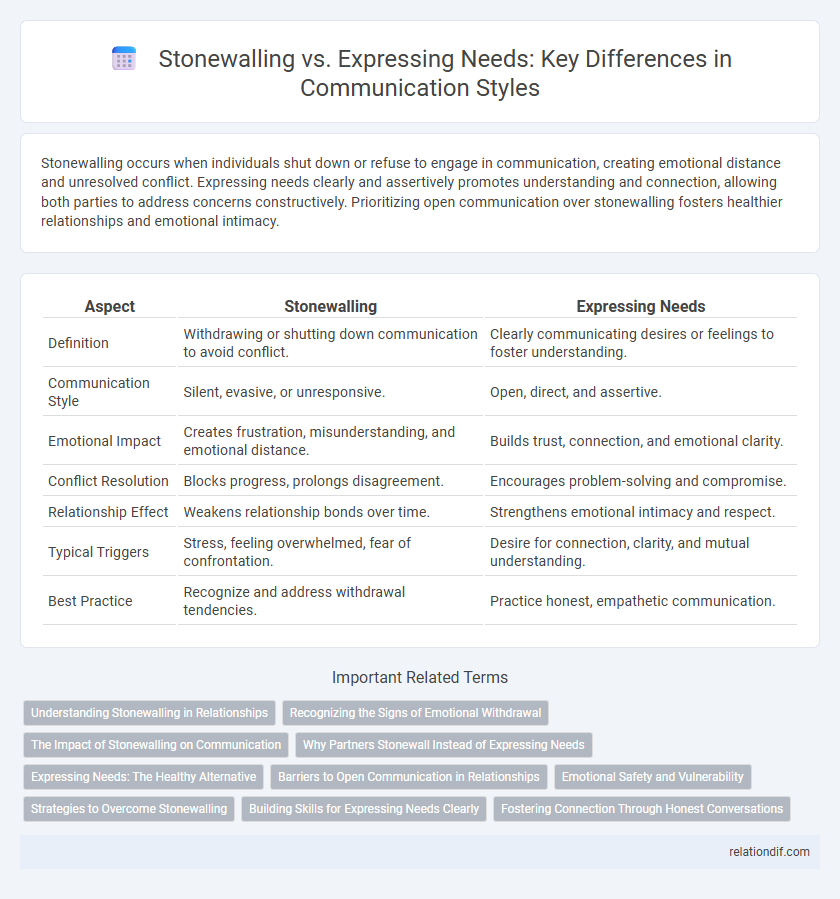Stonewalling occurs when individuals shut down or refuse to engage in communication, creating emotional distance and unresolved conflict. Expressing needs clearly and assertively promotes understanding and connection, allowing both parties to address concerns constructively. Prioritizing open communication over stonewalling fosters healthier relationships and emotional intimacy.
Table of Comparison
| Aspect | Stonewalling | Expressing Needs |
|---|---|---|
| Definition | Withdrawing or shutting down communication to avoid conflict. | Clearly communicating desires or feelings to foster understanding. |
| Communication Style | Silent, evasive, or unresponsive. | Open, direct, and assertive. |
| Emotional Impact | Creates frustration, misunderstanding, and emotional distance. | Builds trust, connection, and emotional clarity. |
| Conflict Resolution | Blocks progress, prolongs disagreement. | Encourages problem-solving and compromise. |
| Relationship Effect | Weakens relationship bonds over time. | Strengthens emotional intimacy and respect. |
| Typical Triggers | Stress, feeling overwhelmed, fear of confrontation. | Desire for connection, clarity, and mutual understanding. |
| Best Practice | Recognize and address withdrawal tendencies. | Practice honest, empathetic communication. |
Understanding Stonewalling in Relationships
Stonewalling in relationships refers to the act of shutting down communication and emotionally withdrawing during conflicts, often leading to unresolved issues and resentment. Recognizing stonewalling as a defense mechanism allows partners to address underlying emotions and foster open dialogue. Expressing needs clearly prevents misunderstandings and promotes emotional connection, reducing the likelihood of withdrawal behaviors.
Recognizing the Signs of Emotional Withdrawal
Stonewalling manifests through silent treatment, refusal to engage, and avoidance of eye contact, signaling emotional withdrawal in communication. Recognizing these signs allows partners to address detachment before it escalates into deeper conflicts. Expressing needs clearly counters stonewalling by fostering openness, trust, and emotional connection in relationships.
The Impact of Stonewalling on Communication
Stonewalling severely disrupts effective communication by causing emotional withdrawal and creating a barrier to understanding, often leading to increased frustration and conflict. When one party refuses to engage or shut downs during conversations, it inhibits problem-solving and mutual empathy, deteriorating relationship trust. Expressing needs openly fosters clarity and connection, contrasting sharply with stonewalling's isolating impact.
Why Partners Stonewall Instead of Expressing Needs
Partners often stonewall to avoid conflict, feeling overwhelmed by emotions or fearing vulnerability when expressing needs. This defensive behavior can stem from past experiences where open communication led to negative outcomes, creating a cycle of withdrawal. Understanding these psychological triggers helps break down barriers and promotes healthier dialogue.
Expressing Needs: The Healthy Alternative
Expressing needs in communication fosters clarity, emotional connection, and mutual understanding, creating a foundation for healthy relationships. Unlike stonewalling, which blocks dialogue and increases resentment, clearly articulating desires and boundaries encourages problem-solving and empathy. Prioritizing open, honest expression of needs reduces conflict and supports emotional well-being.
Barriers to Open Communication in Relationships
Stonewalling creates significant barriers to open communication by shutting down dialogue and preventing emotional connection, leading to misunderstandings and unresolved conflicts. Expressing needs clearly helps overcome these barriers by fostering transparency, trust, and emotional safety in relationships. Effective communication relies on vulnerable self-disclosure and active listening to bridge gaps caused by avoidance behaviors like stonewalling.
Emotional Safety and Vulnerability
Stonewalling undermines emotional safety by shutting down communication and increasing feelings of isolation, whereas expressing needs fosters vulnerability, trust, and deeper connection. Prioritizing open dialogue about emotions encourages mutual understanding and reduces defensive behaviors. Emotional safety is strengthened when partners actively share and validate each other's needs without judgment.
Strategies to Overcome Stonewalling
Overcoming stonewalling involves actively expressing needs through clear, honest communication to prevent emotional shutdown. Strategies include taking brief timeouts to cool down, practicing active listening, and using "I" statements to convey feelings without blame. Consistent emotional engagement and vulnerability foster trust and reduce the impulse to withdraw during conflicts.
Building Skills for Expressing Needs Clearly
Building skills for expressing needs clearly involves recognizing emotions and using "I" statements to communicate feelings without blame. Stonewalling, characterized by shutting down or withdrawing during conversations, hinders effective communication and relationship growth. Practicing assertiveness and active listening fosters a safe environment where individuals can articulate their needs confidently and resolve conflicts constructively.
Fostering Connection Through Honest Conversations
Stonewalling, characterized by withdrawal and silence, obstructs emotional intimacy and stalls productive dialogue, impeding authentic connection. Expressing needs clearly fosters trust and understanding, creating a safe space for vulnerability and mutual respect. Honest conversations build a foundation of empathy, enabling stronger, more resilient relationships through open communication.
Stonewalling vs Expressing needs Infographic

 relationdif.com
relationdif.com